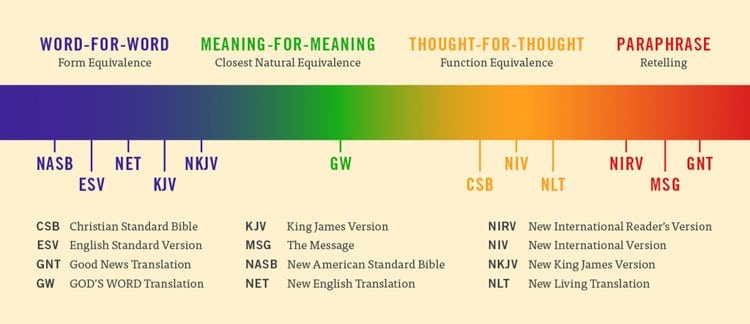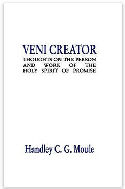Chart of Bible Translations is a short post about the spectrum of differences between common English Bibles, and where they are as far as being literal Translations
Chart of Bible Translations

Chart of Bible Translations

Moule Veni Creati is an old, well known work in studies in the Holy Spirit by Bishop (Anglican) H.G.C. Moule. It has 12 chapters. It is a deep treatment of the Holy Spirit. Although Moule was Anglican, his writings are well written and good.
Downloads:
theWord: Moule Veni Creati
MySword: Moule Veni Creati
ESword:Moule Veni Creati
Adobe Acrobat PDF: Moule Veni Creati
Introduction
In the chart above, you will see the spectrum. Depending on what your purpose is in using one of these Bibles, your could go the extreme in one direction or the other.
The truth of the matter is, you want to know what God has said in a passage, and how He said it and the inflections and other not so easy to pin down parts of that communication. So if that is what you want and you want the absolute BEST source, then none of these Bibles is it. You need to learn Greek and Hebrew and go to an original language Bible.
Even using a Greek NT or Hebrew OT, there are differences in the Greek manuscripts basically that would throw the question of the single best source into a matter of analysis and some opinion. Some people would content that the NT was written in Aramaic instead of Greek (which only Matthew has strong Aramaic flavor, but it was not only written in Aramaic and then translated into Greek).
What is the Focus then?
So the key here is that these Bibles are only going to be really useful for some people who cannot go back to the original Greek and Hebrew and translate a verse for themselves. The Interlinear versions would thus be the closest thing for those who maybe are on the border of actually learning a biblical language but have not yet done so, or are in the process of doing so.
As most first year Greek teachers would say, a little knowledge is a dangerous thing. Here this is exactly right. Somebody who know the noun cases in Greek think they know a lot, but their little knowledge is puffing up their head, and they are given to be dogmatic in their actual ignorance. If a person does not know how to translate from the Greek or Hebrew Bible into English, then they are not any kind of expert source, and mostly they should be ignored. They may be right a lot of times, but still they don’t know what they are doing.
Word-for-Word
These Bibles present a problem for many. First of all, they ignore English grammar, and they try to represent as best as they can the Greek or Hebrew grammar, and quite frankly, the order is all wrong most of the time between either of the biblical languages and English. (Yes I know small parts of the OT are in Aramaic but they are not very many verses).
A word for word Bible is good basically to see what Greek vocabulary is underlying a verse. In other words, you can see some of the added English words that are not in the original. While translators rightly do this, you cannot assume a particular passage that has added words is wrong to add them or is valid unless you are something of an expert in translating or reading Greek and Hebrew.
But for example, if you had a year or two of Greek and have forgotten a lot of it, then this kind of Bible can be extremely helpful.
Note: One of the most important works around for Bible study is Strongs Concordance. It is keyed according to the Greek and Hebrew words with a number G1 H300, and by using a Bible that has these Tags, you can get a whole lot better understanding of the underlying biblical language vocabulary than an interlinear Bible.
- See my Post on using Strong’s Numbers with the free theWord Bible Program.
Meaning-for-Meaning
As we move across the above chart, we need to understand something. There is a literal Greek or Hebrew vocabulary and grammar, and that is very different from English grammar. So what a Bible translator does is to “smooth out” a translation moving it from the word-to-word to the more readable English way somebody would say the same thing.
Therein is the big problem. As you do this, the actual understanding and theological positions of the translator enter into what he decides is better or excellent English, and therein his position, views, and understanding takes a strong hold in the translation. There are some translators that may be able to keep their own theology out of their version of the Bible, but usually they are part of a denomination or religious group, and that group pressures them to adjust their translation to be in keeping with the group’s theology.
As an extremely gross example of this is the New World Version of the Bible translated by the Jehovah’s Witnesses. The group denies Jesus is fully God, so they manipulate the verses to accommodate that theological position (and they have a lot of these kinds of things to hide the Bible’s denouncing of their false theology).
John 1:1 In the beginning the Word was, and the Word was with God, and the Word was a god. -New World Translation of Jehovah’s Witnesses
Here the significant point is that they took the liberty to lowercase the last word, “god” In Greek, the capital letters did not enter into the language until post NT times. So some manuscripts at the beginning, soon after the NT was written was written in all 100% capital letters, and some were all lowercase. That being the case, the Bible translator has to discern which is best in each passage according to proper rules of English grammar. Greek grammar is not in view here because probably the entire NT was written in lowercase Greek.
So think for a minute, why do we capitalize “God” in our language? Because capitalized it refers to the one and only true Supreme being. We lowercase other cases of the word to indicate a false god. So did the original writers of the Greek NT think of Jesus as a false god? No. The general drift of the entire New Testament is that these people were witnesses to the fact that God was incarnated in the person of Jesus Christ. There are no “classes” of the one true Supreme Being God. They say Jesus is the son of God, or in other words, Jesus was a creation of Jehovah, Jehovah being the supreme being and Jesus being a created angel. Where does that place Jesus? As an inferior to the Supreme Being.
Thought-for-Thought
Paraphrase
Chart of Bible Translations
Advertisement

Dixon The Holy Spirit in life and service is a 19 chapter work on the Holy Spirit and various of His relationships and how He works. Chapters on the Personality and Deity of the Holy Spirit, His relationship with young people, the Bible, Bible study, the Evangelist, the Sunday School Teacher, the Pastor, the Christian worker, the purity of the Mind, missions, Christ, etc.
PDF: Dixon The Holy Spirit in life and service
theWord: Dixon The Holy Spirit in life and service
MySword: Dixon The Holy Spirit in life and service
eSword: Dixon The Holy Spirit in life and service
